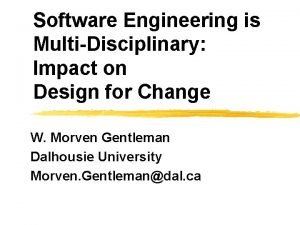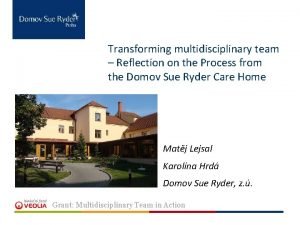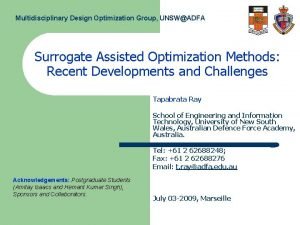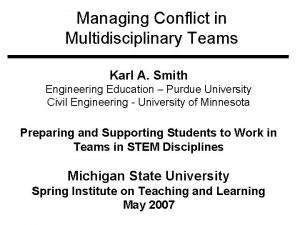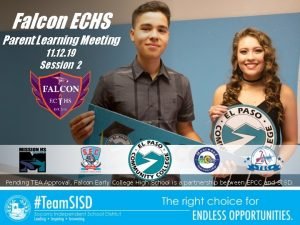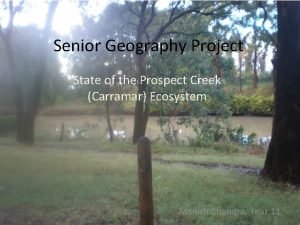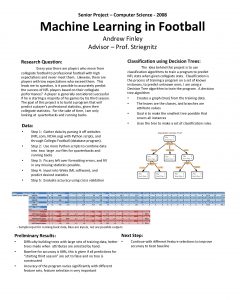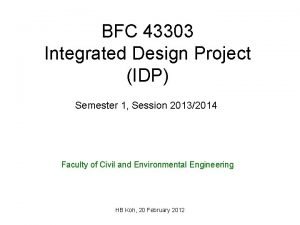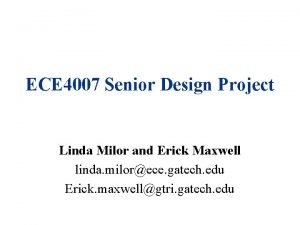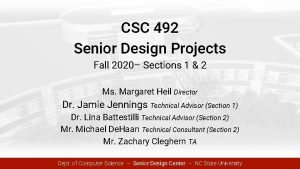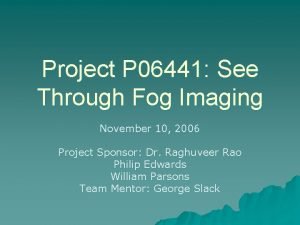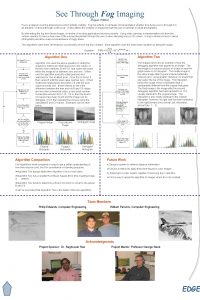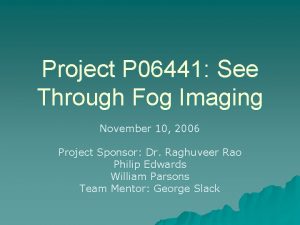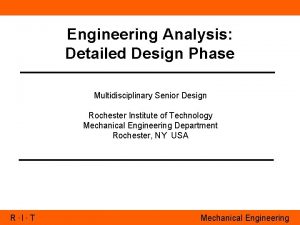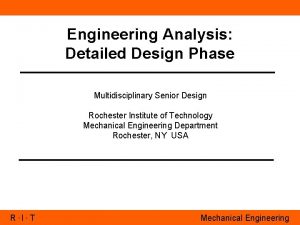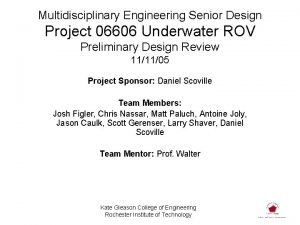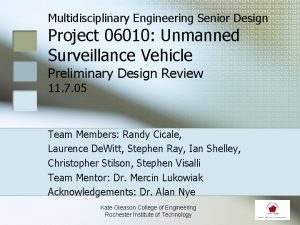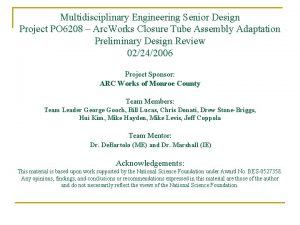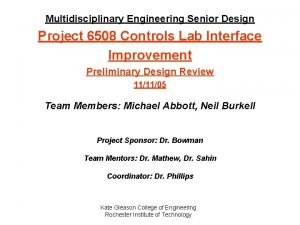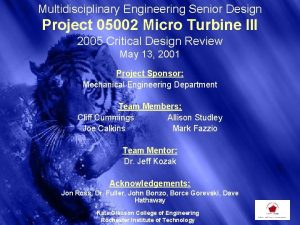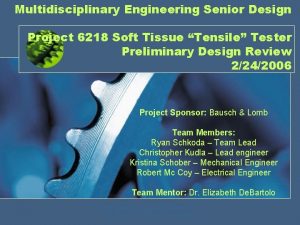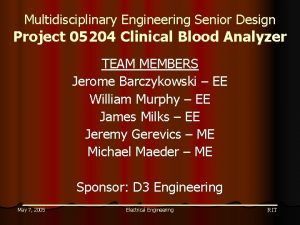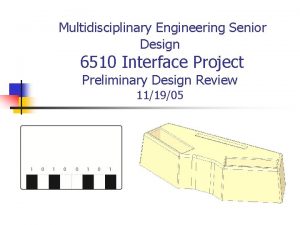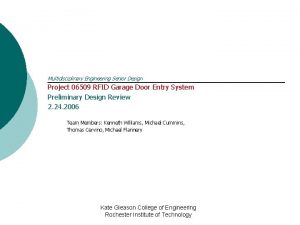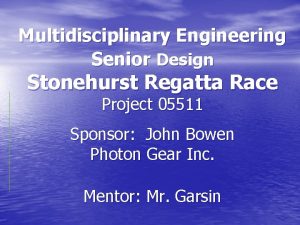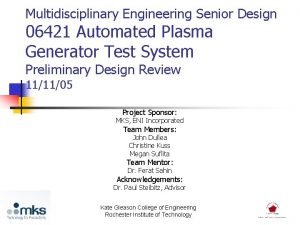Multidisciplinary Engineering Senior Design Project P 06441 See






















- Slides: 22

Multidisciplinary Engineering Senior Design Project P 06441 See Through Fog Imaging Preliminary Design Review 05/19/06 Project Sponsor: Dr. Rao Team Members: William Parsons, Philip Edwards Team Mentor: Dr. Rao Kate Gleason College of Engineering Rochester Institute of Technology


Objective ► Characterize and optimize two different algorithms for removing fog § Each algorithm uses the same basic equation: ► F(k)=((I(k)/C 0 – 1)*exp(B*dist(k))) + 1 § Equation affects image at the pixel level ► Characterize parameters used to defog § B, C 0, precision, threshold values ► Compare speed, quality, and overall performance of both algorithms

Project Background ► Currently small amount of data published on this process § Basic work to ensure current algorithms perform correctly § Only tested on artificially induced fog § No characterization of parameters

Needs Assessment ► Processing speed § For traveling applications speed is a major factor ► Quality of Image § For surveillance applications quality should be very high ► Overall § § § Performance with different degrees of fog Amount of noise each can handle Accuracy of the constant predictions ► B, C 0

Key Requirements and Critical Parameters ► High quality of defogged images § Low distortion ► Processing time § Must produce images reasonable quickly ►B § Crucial to removing fog from images ► C 0 § Also affects the amount of fog removed § Early estimates suggest it is not as crucial as B

Design Concepts ► Color images § Defog color images instead of black and white ► Hardware Realization § Sample images from a camera, defog images, send to LCD screen ► Analysis of Algorithms § Characterize parameters used in each algorithm § Optimize algorithms to increase overall performance

Chosen Design ► Analysis of the two algorithms § Not enough information known about other designs to make it feasible to design anything else § Determine good initial values for B and C 0 § Determine reasonable threshold values

Chosen Design § Determine reasonable precision needed to correctly approximate constants ►Early tests suggest precision may need to be changed after each run through the algorithms § Determine differences in the two algorithms ►Speed ►Quality ►Size of algorithm § Certain applications may only have a small amount of space available for algorithm

Algorithm Overviews ► Each algorithm attempts to determine some constant values in the equation § B, C 0 for first algorithm, B for the second Each scales the pixels in the fogged image to be between zero and one ► Guess at initial values and then change them to make particular pixel values converge ► § Smallest pixel value to zero and largest pixel value to one ► Subtracts current constant values with previous values and compares with threshold values § If they’re smaller, constants have been found § Otherwise calculate new values

Overall System Design

Removing Induced Fog

Inducing fog in images ► In order to successfully test the algorithms, fog must be artificially induced on images § § § Allows us to know correct B and C 0 values Do not need to determine distance vector, dist(k) Can compare defogged image with original image ► Visual inspection ► Histograms ► Frequency Analysis ► etc

Inducing Fog

Anticipated Design Challenges ► Determining correct amount of precision § Early tests lead us to believe precision will need to be changed each time through the algorithm ► Determining distance vector in natural fog § Images where fog is not induced will have different distance vectors § Need to determine an algorithm to calculate the distance to each pixel ► Determining threshold values for each constant ► Testing with natural fog

Algorithms Precision ► Algorithm comes close to approximating B and C 0 values on first run ► Successive runs show no improvement in either parameter ► Precision value needs to be changed after each run through algorithm

Distance Vector ► Multiplied by B constant in both algorithms ► Greatly affects transformation done on pixel values

Threshold Values ► Determines when B and C 0 have been successfully approximated ► Need to determine when algorithms changes on the pixels is to small to notice ► Also need to determine if this implies the constants are correctly approximated

Preferred Analysis Methods ► Visual Inspection ► Histogram ► Frequency Analysis ► Least Mean Square Error ► Noise Sensitivity

Senior Design II ► Parameter approximation should be close to actual values ► Algorithms should run as quickly as possible ► Defogging of natural fog should be implemented ► Efficient way to determine distance vector in natural fog images should be found

Senior Design II ► Affects of different parameters should be determined ► Comparisons of algorithms overall performance should be made § Processing Speed § Image Quality § Performance with differing amounts of fog

Questions?
 Multidisciplinary engineering definition
Multidisciplinary engineering definition Ee senior design project ideas
Ee senior design project ideas Scope of multidisciplinary nature of environmental studies
Scope of multidisciplinary nature of environmental studies Multidisciplinary team pros and cons
Multidisciplinary team pros and cons Temasek laboratories
Temasek laboratories Multidisciplinary vs interdisciplinary
Multidisciplinary vs interdisciplinary What is interdisciplinary
What is interdisciplinary Sunderlal bahuguna quotes in malayalam
Sunderlal bahuguna quotes in malayalam Conflict in multidisciplinary teams
Conflict in multidisciplinary teams Multisectoral and multidisciplinary
Multisectoral and multidisciplinary Interdisciplinary multidisciplinary transdisciplinary
Interdisciplinary multidisciplinary transdisciplinary Multidisciplinary studies epcc
Multidisciplinary studies epcc Senior project presentation template
Senior project presentation template Senior project outline
Senior project outline Senior geography project ideas
Senior geography project ideas Capstone project outline example
Capstone project outline example Senior exit presentation
Senior exit presentation Machine learning senior project ideas
Machine learning senior project ideas Idp project for civil engineering
Idp project for civil engineering Ucf senior design
Ucf senior design Ece senior design gatech
Ece senior design gatech Ncsu csc senior design
Ncsu csc senior design See system design
See system design
